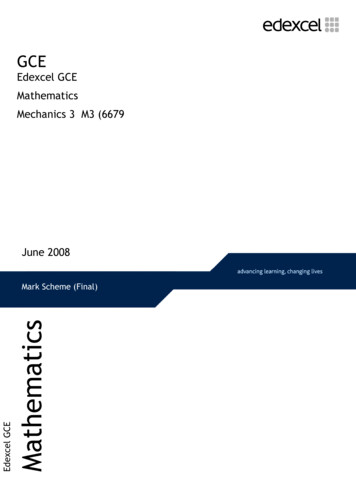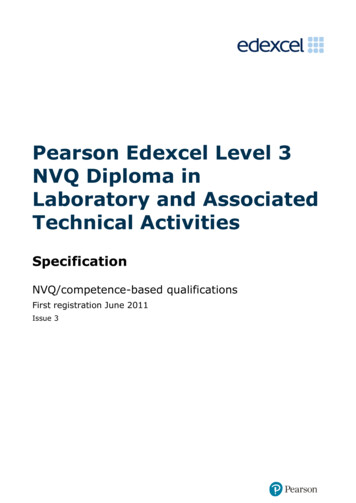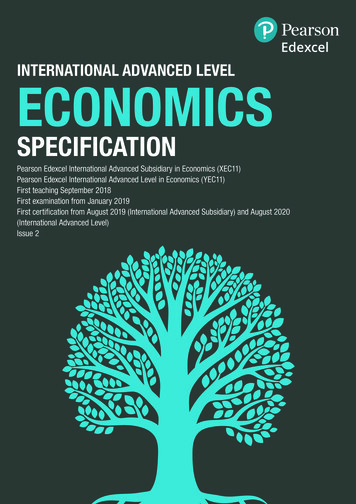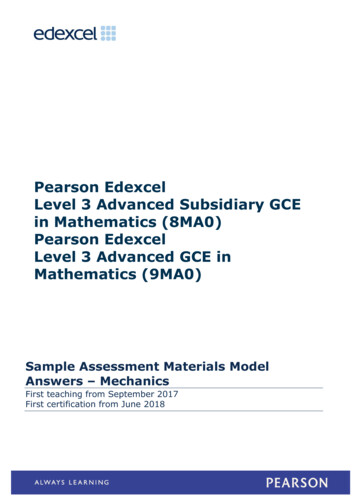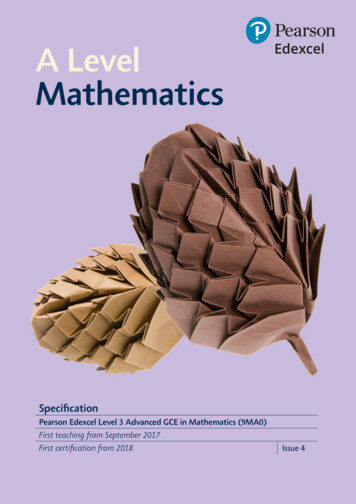
Transcription
A LevelMathematicsSpecificationPearson Edexcel Level 3 Advanced GCE in Mathematics (9MA0)First teaching from September 2017First certification from 2018Issue 4
Summary of Pearson Edexcel Level 3 Advanced GCEin Mathematics Specification Issue 4 changesSummary of changes made between previous issue and this currentissuePage numberPaper 1 and Paper 2: Pure Mathematics, Section 1.1 – Example of proof byexhaustion in guidance replaced with better example.11Paper 1 and Paper 2: Pure Mathematics, Section 1.1 – Square root symbolchanged to include bar over 2.11Paper 1 and Paper 2: Pure Mathematics, Section 2.3 – Text in guidance changedfrom ‘use of a calculator and completing the square’ to ‘use of calculator orcompleting the square’ to clarify wording.12Paper 1 and Paper 2: Pure Mathematics, Section 2.4 – Text in guidance changedfrom ‘The quadratic may involve powers of 2.’ to ‘This may involve powers of2.’ for clarity.12Paper 1 and Paper 2: Pure Mathematics, Section 2.5 – Three inequality symbolsin guidance changed to not bold.13Paper 1 and Paper 2: Pure Mathematics, Section 2.6 – Text in the guidancechanged to clarify that roots can be fractional.13Paper 1 and Paper 2: Pure Mathematics, Section 2.7 – ‘graphs’ changed to‘graph’.14Paper 1 and Paper 2: Pure Mathematics, Section 2.7 – Text ‘Direct proportionbetween two variables’ removed from guidance to avoid misinterpretation that itsuggests only direct proportion is included.14Paper 1 and Paper 2: Pure Mathematics, Section 3.3 – Fixed typo – deleted ‘5’before ‘describes’.17Paper 1 and Paper 2: Pure Mathematics, Section 4.2 – Bracket in equationchanged from italic to roman.18Paper 1 and Paper 2: Pure Mathematics, Section 5.3 – π / 2 removed from list ofexact values required for tan, to match DfE content.19Paper 1 and Paper 2: Pure Mathematics, Section 5.5 – Inserted space before‘and’.20Paper 1 and Paper 2: Pure Mathematics, Section 6.4 – Plus sign made notsubscript.21Paper 1 and Paper 2: Pure Mathematics, Section 6.4 – Fixed typo – deletedinequality symbol from ‘k logax’.21Paper 1 and Paper 2: Pure Mathematics, Section 6.7 – Deleted ‘second’ from‘Consideration of a second improved model may be required’ to makeexpectation clearer.22Paper 1 and Paper 2: Pure Mathematics, Section 7.1 – First sentence of guidancemade bold.23Paper 1 and Paper 2: Pure Mathematics, Section 7.3 – Line removed fromcontent and guidance column.23
Paper 1 and Paper 2: Pure Mathematics, Section 7.6 – Text ‘which may includedirect proportion’ deleted from guidance. Example added.24Paper 1 and Paper 2: Pure Mathematics, Section 8.2 – Fixed typo – deleted ‘x’from end of first sentence in guidance.24Paper 1 and Paper 2: Pure Mathematics, Section 8.3 – Two parts of guidance textmade bold.25Paper 1 and Paper 2: Pure Mathematics, Section 8.5 – Integration by substitutiontext deleted from guidance as it was a repetition of text in content column.25Paper 1 and Paper 2: Pure Mathematics, Section 10.1 – Full stop made not bold.27Paper 1 and Paper 2: Pure Mathematics, Section 10.2 – Vector ‘a’ changed toroman.27Paper 1 and Paper 2: Pure Mathematics, Section 10.4 – Formula for distancebetween two points in three dimensions added to guidance (not bold).27Paper 1 and Paper 2: Pure Mathematics, Section 10.5 – Text about use of ratiotheorem deleted to avoid confusion over ‘ratio theorem’.28Assessment information – ‘Mathematical Formulae and Statistical Tables’29Synoptic assessment – ‘assesses’ corrected to ‘assess’.29Paper 3: Statistics and Mechanics, Section 2.2 – Paragraphs reordered, sometext deleted to avoid repetition.31Paper 3: Statistics and Mechanics, Section 5.2 – Line deleted from acrossContent and Guidance columns.35Paper 3: Statistics and Mechanics, Section 6.1 – Guidance made bold.35Paper 3: Statistics and Mechanics, Section 7.1 – Guidance made bold.36Paper 3: Statistics and Mechanics, Section 7.3 – Sentence starting ‘Understandand use suvat formulae.’ made not bold and moved down a row.36Paper 3: Statistics and Mechanics, Section 7.4 – ‘r’, ‘v’, ‘a’ and ‘t’ italicised inintegrals.36Paper 3: Statistics and Mechanics, Section 7.4 – Cross-reference corrected inguidance.36Paper 3: Statistics and Mechanics, Section 8.2 – Order of paragraphs changed inguidance.37Paper 3: Statistics and Mechanics, Section 8.3 – Section starting ‘The inversesquare law.’ moved from guidance to content, as it is part of DfE wording.37Paper 3: Statistics and Mechanics, Section 8.4 – Text ‘restricted to forces in twoperpendicular directions or simple cases of forces given as 2-D vectors’ added tocontent to match DfE wording.38Breakdown of Assessment Objectives – Ranges for AO2 and AO3 changed.41italicised.Earlier issues show previous changes.If you need further information on these changes or what they mean, contact us via our websiteat: tml.
Contents1Introduction2Why choose Edexcel A Level Mathematics?2Supporting you in planning and implementing this qualification3Qualification at a glance527Subject content and assessment informationPaper 1 and Paper 2: Pure Mathematics11Paper 3: Statistics and Mechanics30Assessment Objectives40342Administration and general informationEntries42Access arrangements, reasonable adjustments, special consideration and malpractice42Student recruitment and progression45Appendix 1: Formulae49Appendix 2: Notation53Appendix 3: Use of calculators59Appendix 4: Assessment Objectives60Appendix 5: The context for the development of this qualification62Appendix 6: Transferable skills64Appendix 7: Level 3 Extended Project qualification65Appendix 8: Codes67
1 IntroductionWhy choose Edexcel A Level Mathematics?We have listened to feedback from all parts of the mathematics subject community, includinghigher education. We have used this opportunity of curriculum change to redesign aqualification that reflects the demands of a wide variety of end users, as well as retainingmany of the features that have contributed to the increasing popularity of GCE Mathematicsin recent years.We will provide: Simple, intuitive specifications that enable co-teaching and parallel delivery. Increasedpressure on teaching time means that it’s important you can cover the content of differentspecifications together. Our specifications are designed to help you co-teach A andAS Level, as well as deliver maths and further maths in parallel. Clear, familiar, accessible exams. Our new exam papers will deliver everything you’dexpect from us as the leading awarding body for maths. They’ll take the moststraightforward and logical approach to meet the government’s requirements. They’ll usethe same clear design that you’ve told us makes them so accessible, while also ensuring arange of challenge for all abilities. A wide range of exam practice to fully prepare students and help you track progress.With the new linear exams your students will want to feel fully prepared and know howthey’re progressing. We’ll provide lots of exam practice to help you and your studentsunderstand and prepare for the assessments, including secure mock papers, practicepapers and free topic tests with marking guidance. Complete support and free materials to help you understand and deliver thespecification. Change is easier with the right support, so we’ll be on hand to listen andgive advice on how to understand and implement the changes. Whether it’s through ourLaunch, Getting Ready to Teach, and Collaborative Networks events or via the renownedMaths Emporium, we’ll be available face to face, online or over the phone throughout thelifetime of the qualification. We’ll also provide you with free materials such as schemes ofwork, topic tests and progression maps. The published resources you know and trust, fully updated for 2017. Our new A LevelMaths and Further Maths textbooks retain all the features you know and love about thecurrent series, while being fully updated to match the new specifications. Each textbookcomes packed with additional online content that supports independent learning and theyall tie in with the free qualification support, giving you the most coherent approach toteaching and learning.2Pearson Edexcel Level 3 Advanced GCE in MathematicsSpecification – Issue 4 – February 2020 – Pearson Education Limited 2020
Supporting you in planning and implementingthis qualificationPlanning Our Getting Started guide gives you an overview of the new A Level qualification to helpyou to get to grips with the changes to content and assessment, as well as helping youunderstand what these changes mean for you and your students. We will give you a course planner and scheme of work that you can adapt to suit yourdepartment. Our mapping documents highlight the content changes between the legacy modularspecification and the new linear specifications.Teaching and learningThere will be lots of free teaching and learning support to help you deliver the newqualifications, including: topic guides covering new content areas teaching support for problem solving, modelling and the large data set a student guide containing information about the course to inform your students and theirparents.Preparing for examsWe will also provide a range of resources to help you prepare your students for theassessments, including: specimen papers written by our senior examiner team practice papers made up from past exam questions that meet the new criteria secure mock papers marked exemplars of student work with examiner commentaries.ResultsPlus and exam WizardResultsPlus provides the most detailed analysis available of your students’ examperformance. It can help you identify the topics and skills where further learning wouldbenefit your students.Exam Wizard is a data bank of past exam questions (and sample paper and specimen paperquestions) allowing you to create bespoke test papers.Pearson Edexcel Level 3 Advanced GCE in MathematicsSpecification – Issue 4 – February 2020 – Pearson Education Limited 20203
Get help and supportMathematics Emporium – support whenever you need itThe renowned Mathematics Emporium helps you keep up to date with all areas of mathsthroughout the year, as well as offering a rich source of past questions and, of course,access to our in-house maths experts Graham Cumming and his team.Sign up to get Emporium emailsGet updates on the latest news, support resources, training and alerts for entry deadlinesand key dates direct to your inbox. Just email mathsemporium@pearson.com to sign up.Emporium websiteOver 12 000 documents relating to past and present Edexcel mathematics qualificationsavailable free. Visit www.edexcelmaths.com to register for an account.4Pearson Edexcel Level 3 Advanced GCE in MathematicsSpecification – Issue 4 – February 2020 – Pearson Education Limited 2020
Qualification at a glanceContent and assessment overviewThe Pearson Edexcel Level 3 Advanced GCE in Mathematics consists of threeexternally-examined papers.Students must complete all assessment in May/June in any single year.Paper 1: Pure Mathematics 1 (*Paper code: 9MA0/01)Paper 2: Pure Mathematics 2 (*Paper code: 9MA0/02)Each paper is:2-hour written examination33.33% of the qualification100 marksContent overview Topic 1 – Proof Topic 2 – Algebra and functions Topic 3 – Coordinate geometry in the (x, y) plane Topic 4 – Sequences and series Topic 5 – Trigonometry Topic 6 – Exponentials and logarithms Topic 7 – Differentiation Topic 8 – Integration Topic 9 – Numerical methods Topic 10 – VectorsAssessment overview Paper 1 and Paper 2 may contain questions on any topics from the Pure Mathematicscontent. Students must answer all questions. Calculators can be used in the assessment.Pearson Edexcel Level 3 Advanced GCE in MathematicsSpecification – Issue 4 – February 2020 – Pearson Education Limited 20205
Paper 3: Statistics and Mechanics (*Paper code: 9MA0/03)2-hour written examination33.33% of the qualification100 marksContent overviewSection A: Statistics Topic 1 – Statistical sampling Topic 2 – Data presentation and interpretation Topic 3 – Probability Topic 4 – Statistical distributions Topic 5 – Statistical hypothesis testingSection B: Mechanics Topic 6 – Quantities and units in mechanics Topic 7 – Kinematics Topic 8 – Forces and Newton’s laws Topic 9 – MomentsAssessment overview Paper 3 will contain questions on topics from the Statistics content in Section A andMechanics content in Section B. Students must answer all questions. Calculators can be used in the assessment.*See Appendix 8: Codes for a description of this code and all other codes relevant tothis qualification.6Pearson Edexcel Level 3 Advanced GCE in MathematicsSpecification – Issue 4 – February 2020 – Pearson Education Limited 2020
2 Subject content and assessmentinformationQualification aims and objectivesThe aims and objectives of this qualification are to enable students to: understand mathematics and mathematical processes in a way that promotes confidence,fosters enjoyment and provides a strong foundation for progress tofurther study extend their range of mathematical skills and techniques understand coherence and progression in mathematics and how different areas ofmathematics are connected apply mathematics in other fields of study and be aware of the relevance of mathematicsto the world of work and to situations in society in general use their mathematical knowledge to make logical and reasoned decisions in solvingproblems both within pure mathematics and in a variety of contexts, and communicate themathematical rationale for these decisions clearly reason logically and recognise incorrect reasoning generalise mathematically construct mathematical proofs use their mathematical skills and techniques to solve challenging problems that requirethem to decide on the solution strategy recognise when mathematics can be used to analyse and solve a problem in context represent situations mathematically and understand the relationship between problems incontext and mathematical models that may be applied to solve them draw diagrams and sketch graphs to help explore mathematical situations and interpretsolutions make deductions and inferences and draw conclusions by using mathematical reasoning interpret solutions and communicate their interpretation effectively in the context of theproblem read and comprehend mathematical arguments, including justifications of methods andformulae, and communicate their understanding read and comprehend articles concerning applications of mathematics and communicatetheir understanding use technology such as calculators and computers effectively and recognise when theiruse may be inappropriate take increasing responsibility for their own learning and the evaluation of their ownmathematical development.Pearson Edexcel Level 3 Advanced GCE in MathematicsSpecification – Issue 4 – February 2020 – Pearson Education Limited 20207
Overarching themesThe overarching themes should be applied along with associated mathematical thinking andunderstanding, across the whole of the detailed content in this specification.These overarching themes are inherent throughout the content and students are required todevelop skills in working scientifically over the course of this qualification. The skills showteachers which skills need to be included as part of the learning and assessment of thestudents.Overarching theme 1: Mathematical argument, language and proofA Level Mathematics students must use the mathematical notation set out in the bookletMathematical Formulae and Statistical Tables and be able to recall the mathematicalformulae and identities set out in Appendix 1.Knowledge/skillOT1.1Construct and present mathematical arguments through appropriate use ofdiagrams; sketching graphs; logical deduction; precise statements involvingcorrect use of symbols and connecting language, including: constant,coefficient, expression, equation, function, identity, index, term, variable.OT1.2Understand and use mathematical language and syntax as set out in thecontent.OT1.3Understand and use language and symbols associated with set theory, as setout in the content. Apply to solutions of inequalities and probability.OT1.4Understand and use the definition of a function; domain and range offunctions.OT1.5Comprehend and critique mathematical arguments, proofs and justificationsof methods and formulae, including those relating to applications ofmathematics.8Pearson Edexcel Level 3 Advanced GCE in MathematicsSpecification – Issue 4 – February 2020 – Pearson Education Limited 2020
Overarching theme 2: Mathematical problem solvingKnowledge/skillOT2.1Recognise the underlying mathematical structure in a situation and simplifyand abstract appropriately to enable problems to be solved.OT2.2Construct extended arguments to solve problems presented in anunstructured form, including problems in context.OT2.3Interpret and communicate solutions in the context of the original problem.OT2.4Understand that many mathematical problems cannot be solved analytically,but numerical methods permit solution to a required level of accuracy.OT2.5Evaluate, including by making reasoned estimates, the accuracy or limitationsof solutions, including those obtained using numerical methods.OT2.6Understand the concept of a mathematical problem-solving cycle, includingspecifying the problem, collecting information, processing and representinginformation and interpreting results, which may identify the need to repeatthe cycle.OT2.7Understand, interpret and extract information from diagrams and constructmathematical diagrams to solve problems, including in mechanics.Overarching theme 3: Mathematical modellingKnowledge/skillOT3.1Translate a situation in context into a mathematical model, makingsimplifying assumptions.OT3.2Use a mathematical model with suitable inputs to engage with and exploresituations (for a given model or a model constructed or selectedby the student).OT3.3Interpret the outputs of a mathematical model in the context of the originalsituation (for a given model or a model constructed or selectedby the student).OT3.4Understand that a mathematical model can be refined by considering itsoutputs and simplifying assumptions; evaluate whether the model isappropriate.OT3.5Understand and use modelling assumptions.Pearson Edexcel Level 3 Advanced GCE in MathematicsSpecification – Issue 4 – February 2020 – Pearson Education Limited 20209
Use of data in statisticsPearson has provided a large data set, which will support the assessment of Statistics inPaper 3: Statistics and Mechanics. Students are required to become familiar with the dataset in advance of the final assessment.Assessments will be designed in such a way that questions assume knowledge andunderstanding of the data set. The expectation is that these questions should be likely togive a material advantage to students who have studied and are familiar with the data set.They might include questions/tasks that: assume familiarity with the terminology and contexts of the data, and do not explain themin a way that gives students who have not studied the data set the same opportunities toaccess marks as students who have studied them use summary statistics or selected data from, or statistical diagrams based on, the dataset – these might be provided in the question or task, or as stimulus materials are based on samples related to the contexts in the data set, where students’ work withthe data set will help them understand the background context and/or require students to interpret data in ways that would be too demanding in an unfamiliarcontext.Students will not be required to have copies of the data set in the examination, nor will theybe required to have detailed knowledge of the actual data within the data set.The data set can be downloaded from our website, qualifications.pearson.com. This data setshould be appropriate for the lifetime of the qualification. However we will review the dataset on an annual basis to ensure it is appropriate. If we need to make changes to the dataset, we will notify centres before the beginning of the two-year course before studentscomplete their examination.10Pearson Edexcel Level 3 Advanced GCE in MathematicsSpecification – Issue 4 – February 2020 – Pearson Education Limited 2020
Paper 1 and Paper 2: Pure MathematicsTo support the co-teaching of this qualification with the AS Mathematics qualification,common content has been highlighted in bold.Topics1ProofWhat students need to learn:Content1.1GuidanceUnderstand and use thestructure of mathematicalproof, proceeding fromgiven assumptionsthrough a series of logicalsteps to a conclusion; usemethods of proof,including:Examples of proofs:Proof by deductionProof by deductione.g. using completion of the square,prove that n2 6n 10 is positive forall values of n or, for example,differentiation from first principles forsmall positive integer powers of x orproving results for arithmetic and geometricseries. This is the most commonly usedmethod of proof throughout thisspecificationProof by exhaustionProof by exhaustionGiven that p is a prime number suchthat 3 p 25, prove by exhaustion,that (p – 1)(p 1) is a multiple of 12.Disproof by counterexampleDisproof by counter examplee.g. show that the statement“n2 – n 1 is a prime number for allvalues of n” is untrueProof by contradiction(including proof of theirrationality of 2 and theinfinity of primes, andapplication to unfamiliarproofs).Pearson Edexcel Level 3 Advanced GCE in MathematicsSpecification – Issue 4 – February 2020 – Pearson Education Limited 202011
Topics2What students need to learn:Content2.1Algebra andfunctions2.22.3GuidanceUnderstand and use thelaws of indices for allrational exponents.12mThe equivalence of a n andnamshouldbe known.Use and manipulate surds,including rationalising thedenominator.Students should be able to simplifyalgebraic surds using the resultsWork with quadraticfunctions and their graphs.The notationThe discriminant of aquadratic function,including the conditionsfor real and repeatedroots.Need to know and to useCompleting the square.2.4am an am n, am an am n, (am)n amn, xyx)x x y and( x y( x y )( x y ) 2f(x) may be usedb2 – 4ac 0, b2 – 4ac 0 andb2 – 4ac 02b b2 ax2 bx c a x c 2a 4a Solution of quadraticequationsSolution of quadratic equations byfactorisation, use of the formula, useof a calculator or completing thesquare.including solving quadraticequations in a function ofthe unknown.These functions could include powersof x, trigonometric functions of x,exponential and logarithmic functionsof x.Solve simultaneousequations in two variablesby elimination and bysubstitution, including onelinear and one quadraticequation.This may involve powers of 2 in oneunknown or in both unknowns,e.g. solvey 2x 3, y x2 – 4x 8or2x – 3y 6, x2 – y2 3x 50Pearson Edexcel Level 3 Advanced GCE in MathematicsSpecification – Issue 4 – February 2020 – Pearson Education Limited 2020
Topics2What students need to learn:Content2.5Algebra andfunctionsSolve linear and quadraticinequalities in a singlevariable and interpret suchinequalities graphically,continuedGuidancee.g. solvingax b cx d,px2 qx r 0,px2 qx r ax band interpreting the third inequalityas the range of x for which the curvey px2 qx r is below the line withequation y ax bincluding inequalities withbrackets and fractions.These would be reducible to linear orquadratic inequalitiese.g.2.6a b becomes ax bx2xx a or x b is equivalent to{x:x a} {x:x b}and { x : c x } { x : x d } isequivalent to x c and x dExpress solutions throughcorrect use of ‘and’ and‘or’, or through setnotation.So, e.g.Represent linear andquadratic inequalities suchas y x 1 andy ax2 bx c graphically.Shading and use of dotted and solidline convention is required.Manipulate polynomialsalgebraically, includingexpanding brackets andcollecting like terms,factorisation and simplealgebraic division; use ofthe factor theorem.Only division bybe required.(ax b) or (ax – b) willStudents should know that ifwhenf(x).x ba, thenf(x) 0(ax – b) is a factor ofStudents may be required to factorisecubic expressions such asx3 3x2 – 4 and 6x3 11x2 – x – 6.Simplify rational expressions,including by factorising andcancelling, and algebraicdivision (by linear expressionsonly).Denominators of rational expressions willbe linear or quadratic,e.g.Pearson Edexcel Level 3 Advanced GCE in MathematicsSpecification – Issue 4 – February 2020 – Pearson Education Limited 20201x3 a3ax b,,ax b px 2 qx r x 2 a 213
Topics2Algebra andfunctionscontinuedWhat students need to learn:Content2.7GuidanceUnderstand and usegraphs of functions; sketchcurves defined by simpleequations includingpolynomialsThe modulus of a linearfunction.Graph to include simple cubic andquartic functions,e.g. sketch the graph with equationy x2(2x – 1)2Students should be able to sketch thegraph of y ax b They should be able to use their graph.For example, sketch the graph withequation y 2x – 1 and use the graph tosolve the equation 2x – 1 x or theinequality 2x – 1 xy axandy ax2(including their verticaland horizontalasymptotes)The asymptotes will be parallel to theaxes e.g. the asymptotes of the curvewith equationy 2 b are thex alines with equationsy b and x aInterpret algebraicsolution of equationsgraphically; useintersection points ofgraphs to solve equations.Understand and useproportional relationshipsand their graphs.Express relationship between twovariables using proportion “ ”symbol or using equation involvingconstante.g. the circumference of a semicircleis directly proportional to its diameterso C d or C kd and the graph of Cagainst d is a straight line through theorigin with gradient k.14Pearson Edexcel Level 3 Advanced GCE in MathematicsSpecification – Issue 4 – February 2020 – Pearson Education Limited 2020
Topics2What students need to learn:Content2.8Algebra andfunctionsUnderstand and usecomposite functions; inversefunctions and their graphs.continuedGuidanceThe concept of a function as a one-one ormany-one mapping from ℝ (or a subset ofℝ) to ℝ. The notation f : x and f(x) willbe used. Domain and range of functions.Students should know that fg will mean‘do g first, then f’ and that if f 1 exists,thenf 1 f(x) ff 1(x) xThey should also know that the graph ofy f 1(x) is the image of the graph ofy f(x) after reflection in the line y x2.9Understand the effect ofsimple transformations onthe graph of y f(x),including sketchingassociated graphs:y af(x), y f(x) a,y f(x a), y f(ax)and combinations of thesetransformationsStudents should be able to find the graphsof y f(x) and y f(–x) , given thegraph of y f(x).Students should be able to apply acombination of these transformations toany of the functions in the A Levelspecification (quadratics, cubics, quartics,reciprocal,anda xx,, sin x, cos x, tan x, e2xax) and sketch the resulting graph.Given the graph ofy f(x), studentsshould be able to sketch the graph of, e.g.y 2f(3x), or y f( x) 1,and should be able to sketch(for example)( )y 3 sin 2x, y cos x 2.10Decompose rational functionsinto partial fractions(denominators not morecomplicated than squaredlinear terms and with nomore than 3 terms,numerators constant orlinear).π4Partial fractions to include denominatorssuch as(ax b)(cx d)(ex f) and(ax b)(cx d)2.Applications to integration, differentiationand series expansions.Pearson Edexcel Level 3 Advanced GCE in MathematicsSpecification – Issue 4 – February 2020 – Pearson Education Limited 202015
Topics2What students need to learn:ContentGuidance2.11Use of functions in modelling,including consideration oflimitations and refinements ofthe models.For example, use of trigonometricfunctions for modelling tides, hours ofsunlight, etc. Use of exponential functionsfor growth and decay (see Paper 1,Section 6.7). Use of reciprocal function forinverse proportion (e.g. pressure andvolume).3.1Understand and use theequation of a straight line,including the formsTo include the equation of a linethrough two given points, and theequation of a line parallel (orperpendicular) to a given line througha given point.Algebra andfunctionscontinued3Coordinategeometry inthe (x,y) planey – y1 m(x – x1) andax by c 0;Gradient conditions fortwo straight lines to beparallel or perpendicular.3.2m′ m for parallel lines and m′ 1mfor perpendicular linesBe able to use straight linemodels in a variety ofcontexts.For example, the line for convertingdegrees Celsius to degreesFahrenheit, distance against time forconstant speed, etc.Understand and use thecoordinate geometry of thecircle including using theequation of a circle in theform ( x – a)2 (y – b)2 r2Students should be able to find theradius and the coordinates of thecentre of the circle given the equationof the circle, and vice versa.Students should also be familiar withthe equation x2 y2 2fx 2gy c 0Completing the square tofind the centre and radiusof a circle; use of thefollowing properties: the angle in a semicircleis a right angle the perpendicular fromthe centre to a chordbisects the chord the radius of a circle at agiven point on itscircumference isperpendicular to thetangent to the circle atthat point.16Students should be able to find theequation of a circumcircle of atriangle with given vertices usingthese properties.Students should be able to find theequation of a tangent at a specifiedpoint, using the perpendicularproperty of tangent and radius.Pearson Edexcel Level 3 Advanced GCE in MathematicsSpecification – Issue 4 – February 2020 – Pearson Education Limited 2020
Topics3What students need to learn:Content3.3Coordinategeometry inthe (x, y) planeGuidanceUnderstand and use thepara
Paper 1 and Paper 2: Pure Mathematics, Section 8.3 – Two parts of guidance text made bold. 25 Paper 1 and Paper 2: Pure Mathematics, Section 8.5 – Integration by substitution text deleted from guidance as it was a repetition of text in content column. 25 Paper 1 and Paper 2: Pure Mathema


